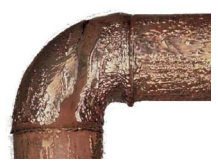Lead
View/Download PDF Version
Lead
Lead is very soft bluish-gray metallic element. It is commonly used in batteries, cable covering, ammunition, gasoline additives, radiation shielding equipment, glass production, and traditionally in paints and solder for plumbing. Lead has been found in moderately high concentrations in natural waters, but usually lead in drinking water comes from plumbing. The degree to which lead from pipes, solder, and fixtures will corrode and introduce lead into drinking water depends on the corrosivity of the water. Dissolved oxygen and low pH are common causes of lead corrosion.
Lead in Drinking Water
Lead is not detectable in water by smell, taste, or sight. In older homes, lead pipes were commonly used for plumbing. More recently, lead solder was used to make connections between copper piping. Regulations were put in place in the 1980s restricting the use of solders containing lead. If water is not corrosive, a coating will form on the plumbing separating the lead from the water supply. If water is corrosive, the lead from the plumbing is dissolved into the water supply. Under these corrosive conditions the lead concentration increases as the water sits in the pipes. This means that the “first draw” from the tap after water has been sitting in the pipes has a higher lead concentration than water that moves quickly through the pipe system. For this reason, if you suspect corrosion of lead plumbing, it is a good idea to have a water tested that is sampled immediately after turning on a tap after leaving the tap off for 12 hours.
Health Effects from Lead
The US Environmental Protection Agency has set 0.015 mg/L as a drinking water standard for lead. This standard only regulates public water systems, but the health implications are relevant for private well owners. High concentrations of lead can cause kidney damage, high blood pressure, and brain damage. Effects can be more severe in children causing delays in physical and mental development.
Treating for Lead
Hot water will leach more lead from plumbing than cold water; avoid using water from the hot water tap for cooking or drinking. Flush the cold water line by running the water for a few minutes before collecting drinking water. You can use cold water to rinse dishes or water plants and then fill jugs for drinking water that can be stored in the fridge.
Alternative choices include:
- replacement of copper plumbing with CPVC or other alternative materials that meet local code
- water treatment with a neutralizing tank filter or caustic liquid treatment to reduce corrosivity of water
- removal of copper by installing an adsorption (i.e. carbon or charcoal), reverse osmosis, or distillation system at the drinking water tap
Additional Resources
Click on the links below to be directed to more resources.
World Health Organization Information
NSF International Home Water Treatment Devices
US EPA Basic Information about Lead in Drinking Water
